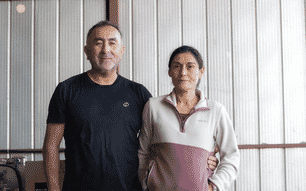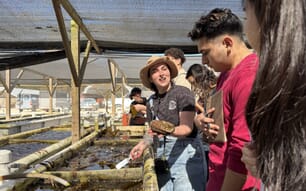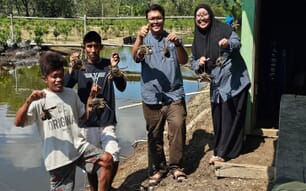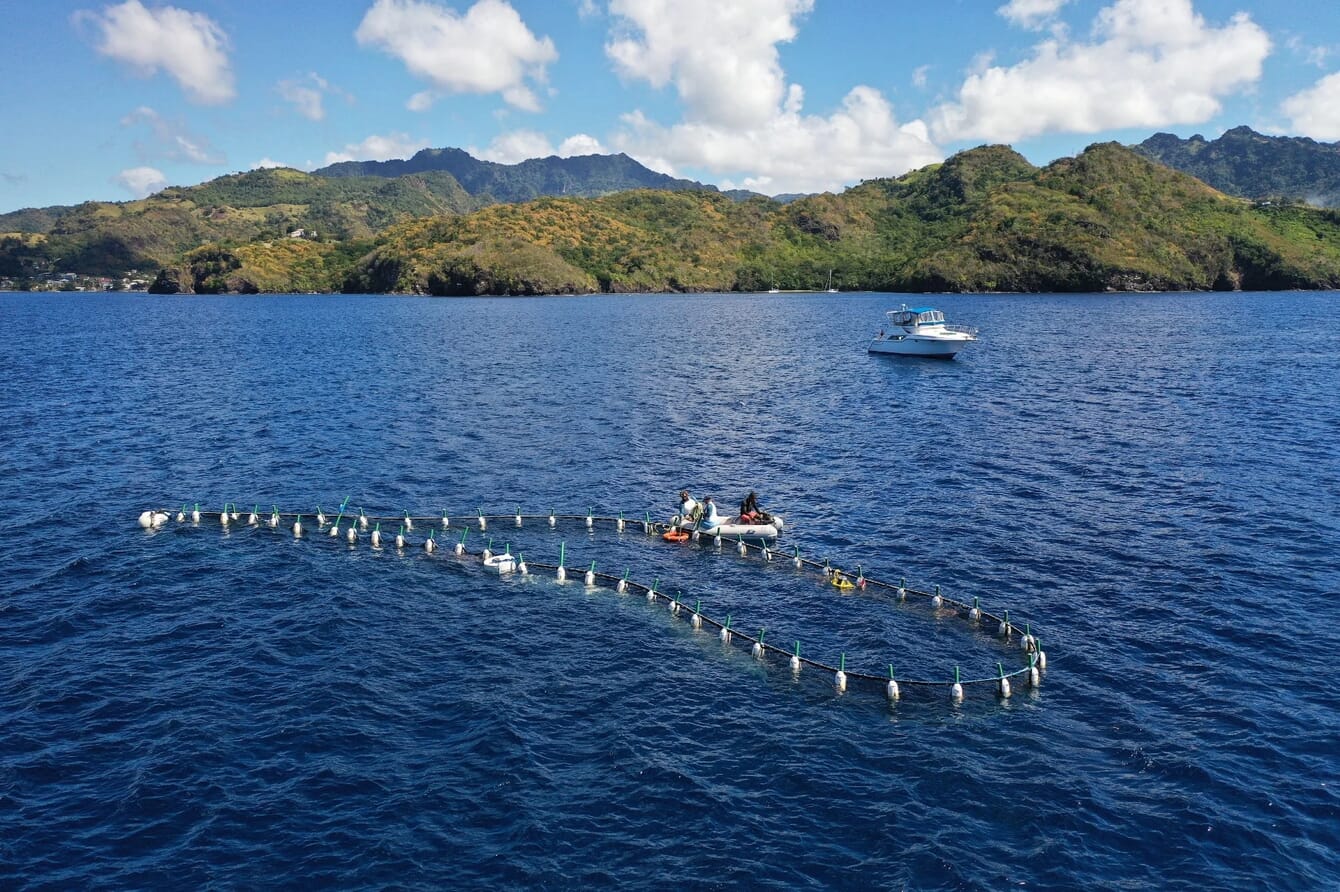
The barriers Seafields are developing will stop the Sargassum seaweed from escaping the farms © Seafields
Can you tell me about Seafields?
We aim to remove carbon from the atmosphere by growing and harvesting floating seaweed in the Atlantic Ocean. We also aim to promote ocean productivity and biodiversity and provide a renewable feedstock to industry as alternatives to fossil fuel-based products.
As well as myself, our executive team is comprised of leading global scientific and business figures, including Randall Purcell, co-founder, who managed the UN Food Programme’s largest climate adaptation programme; Dr Mar Fernández-Méndez, a marine microbiology expert who has participated in several ocean research expeditions, including artificial upwelling experiments; and Prof Victor Smetacek, former head of the division pelagic ecosystems of the Alfred Wegener Institute Helmholtz Centre for Polar and Marine Research and has over 20 published papers in Nature and Science.
Can you tell me a bit about your own background?
I’m a crowdfunding specialist and founder of TribeFirst – a global equity crowdfunding communications agency. We have helped raise in excess of £40 million for over 75 companies on major equity crowdfunding platforms, including a combined total of 114 Crowdcube and Seedrs campaigns, with a greater than 90 percent success rate.
I am also a Virgin StartUp's crowdfunding trainer and consultant, helping them to run branded workshops, webinars and programmes on crowdfunding. I am very passionate about working with startups and see crowdfunding as more than just raising funds; it's an opportunity to build a loyal tribe of lifelong customers and supporters.
Lastly, I am a futurist and twice-published sci-fi author.
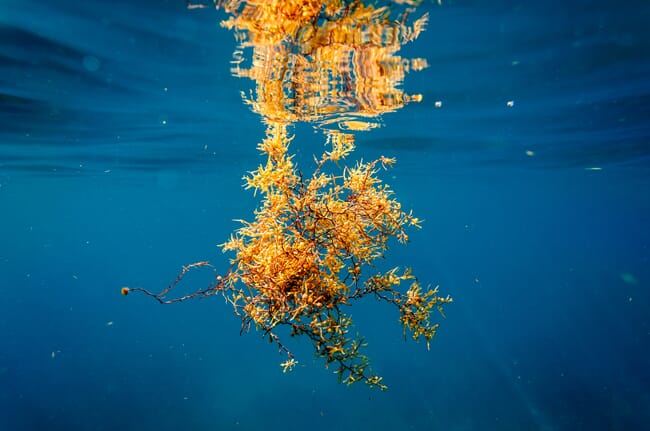
Named after where it originated in the Sargasso Sea, Sargassum is a floating seaweed that has small air-filled “berries” that allow it to float in the sea © Shutterstock
What inspired you to try to start farming seaweed?
The original idea for Seafields came from Sebastian Stephens, a serial entrepreneur who also set up SubSea Environmental Services. Sebastian devised the idea after initially investigating sustainable fuel for a new airline for island nations. His research into what products can be used for bioethanol led him to The Sargassum Podcast – in which Victor and Mar discuss the benefits and opportunities for climate change that Sargassum holds. Very quickly, Sebastian assembled myself, Victor, Mar and a team of experts passionate to bring this vision to life. After hearing the podcast I had no hesitation in being a part of the team to bring this vision to a reality.
As part of her research, Mar found that there are a number of ocean-based solutions for carbon capture. She initially looked into enhancing phytoplankton growth using wave pumps for artificial upwelling during her time at Ulf Riebesell’s group at Geomar. Here she discovered that the key issues to sequestering carbon through this approach is the efficiency of the carbon uptake per unit of nutrient provided and the fate of the biomass. Phytoplankton either sink slowly or are consumed right away, entering the complex marine food web, making it very challenging to track the fate of the carbon they took up.
It was then that she realised the potential of the floating seaweed Sargassum natans and Sargassum fluitans – they have a high carbon sequestration efficiency and are rapid growers (they can double in biomass in a mere 1-3 weeks). They have high productivity rates, are free-floating, can sink rapidly (when the air cysts burst), and are not tasty – so animals don't eat your farm!
So, the team decided to test developing a solution to grow the Sargassum offshore in the ocean deserts (the subtropical gyres), providing nutrients from the deep waters using double upwelling pipes that use the energy of the temperature and salinity differences in the ocean to bring nutrient-rich waters to the surface and fertilise the seaweed.
Can you explain the design in more detail?
The design and construction of a modular counter-pipe, based on the Stommel salt fountain principle, is an engineering challenge. We are currently modelling upwelling pipes with a diameter of 1.2 metres with 20-50 inner pipes that can float freely at between 50 and 400 metres depth. Our upwelling pipe currently has the maximum diameter that is commercially viable, but modelling has shown that the upwelling rate can only be significantly increased if the diameter of the pipe is increased, and the commercial feasibility of much larger pipes is currently being investigated in feasibility studies.
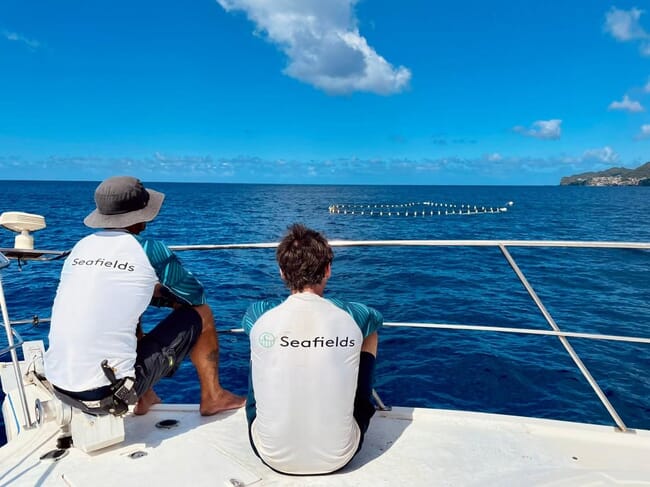
The team have learned a lot during initial trials about deploying a free-floating, self-opening barrier that will effectively contain the Sargassum and not collapse with changing wind and current conditions © Seafield
Another major challenge we foresee is biofouling, and we are in contact with companies developing technologies to prevent biofouling in the ocean. The initial assembly of the pipes will be handmade by a specialist engineering shop, but we plan to use novel technologies such as 3D-printing to build the pipes in a modular way so that they can be transported and assembled in place. The ultimate goal is for Seafields' pipes to be made from Sargassum-derived plastic.
Why Sargassum?
Sargassum is floating seaweed that originated in the Sargasso Sea. It has small air-filled “berries” that allow it to float like islands in the sea. Carbon makes up around 30 percent of its dry mass. In its natural state, Sargassum is an important support habitat for marine life such as shrimps, crabs and sea turtles, plus larger fish species, such as tuna and marlin. In recent years, however, warming sea temperatures and extra nutrients in the sea have created a perfect combination for it to over-thrive and become a problem.
Due to the warming of the oceans and wind anomalies, Sargassum has escaped its natural environment and has now established The Great Atlantic Sargassum Belt, extending from the Caribbean Sea all the way to the west coast of Africa. When it spreads to coastal waters, it causes a multitude of issues – when it washes up on beaches it releases sulphuric fumes, damaging coastal ecosystems and driving away tourists.
However, Sargassum also has many beneficial uses, including as a fertiliser, in bioplastics, biofuels and even construction materials. Firstly, it can provide emission avoidance from fossil fuel-based product replacement. For example, typical fertiliser production usually produces a lot of CO2, but if you make it from Sargassum (which is actually sequestering carbon), this is a substantial net climate gain. Secondly, we can sink the carbon-rich leftover to act as long-term carbon storage after using all the valuable parts.
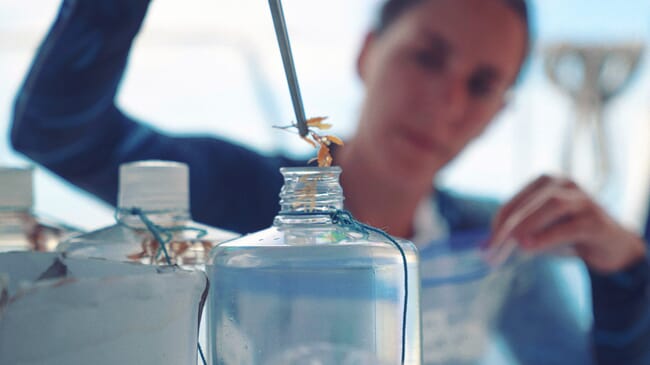
The two species of Sargassum seaweed that Seafields is working with are Sargassum natans and Sargassum fluitans, which have a high carbon sequestration efficiency and are rapid growers, doubling in biomass in 1-3 weeks © Seafields
By farming Sargassum and then processing, baling and sinking it to the bottom of the ocean, we will be storing carbon for the future and preventing the immediate release of that carbon into the atmosphere. By upscaling our mid-ocean farms in the subtropical gyres, we will aim to dramatically reduce remineralisation - the rate at which deep-sea bacteria and other organisms feed on and break down the carbon-rich biomass – at the seafloor, enhancing the natural carbon sequestration process.
Doesn’t farming this species on such a large scale pose a risk?
We expect positive impacts on the marine ecosystem, both at the surface and in the deep sea.
There are millions of tonnes of floating Sargassum in the Great Atlantic Sargassum belts. Some of it sinks naturally to the bottom of the ocean, but another large fraction ends up on the beaches of the Caribbean, rotting and releasing CO2 back to the atmosphere. Preventing Sargassum reaching land is a great way to avoid CO2 emissions, however, this would not be considered additional CO2 removal from the atmosphere, since the Sargassum was naturally occurring. Only if we enhance Sargassum’s growth, via ocean afforestation, are we actually additionally sequestering carbon from the atmosphere. In addition, harvesting the naturally-occurring Sargassum blooms would be too energy-intensive because it’s very spread out (for scale, it’s like spreading a country the size of Luxemburg in a country like Brazil and trying to collect the pieces).
The barriers we are developing for the farms will stop the seaweed from escaping. We recently tested the first barrier prototype in St Vincent and we are confident of its ability to contain Sargassum, even in difficult seas. We are currently improving the design to increase the surface area inside the barrier. Our monitoring technologies (GPS and drones equipped with sensors) will make the tracking and relocation of our farms possible, even under tough conditions. From our initial trials we don't foresee adverse issues with large marine life entanglement, since our structures are flexible, but we will monitor this with underwater cameras in the prototype farms. We are also working on systems to prevent any surface bycatch of smaller marine life.
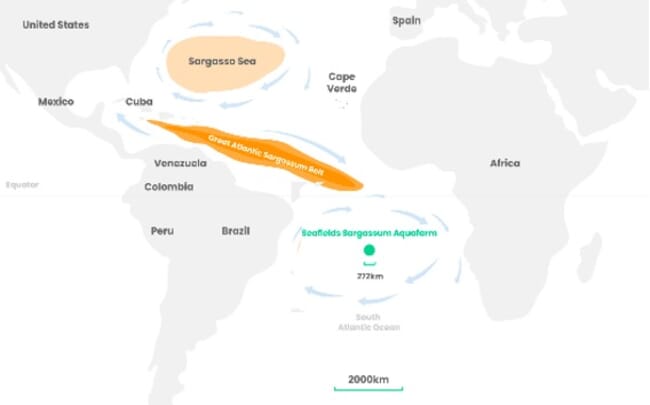
Where do you intend to site your farms?
Our Sargassum farms will be in the South Atlantic Gyre, which is the equivalent of the Sahara Desert in the ocean. In contrast to the biodiverse and unique coastal ecosystems along the continental margins, the surface waters of the vast open ocean are quite homogenous and very little lives and grows there. We expect that our aquafarms will also have the co-benefit of being nurseries, habitats and feeding grounds for commercially important fish species – including shrimps, crabs, eels, tuna and marlin – providing food sources that don’t rely on depleting terrestrial resources, and creating significant employment opportunities. These fisheries will provide food security for a growing global population.
Finally, the South Atlantic Gyre is not crossed by major shipping routes or the migration paths of whales, and our farms will take up only a small fraction of the total area of the gyre.
How do you intend to seed, grow and harvest the seaweed?
The two species Sargassum natans and fluitans that we work with are free-floating for their entire life cycle, so need neither rocks nor soil. This makes it possible for them to grow in the open ocean, which is a much bigger area than the shallow coastal waters suited for growth of mangroves, seagrasses and benthic seaweeds.
What have you learnt from your trials and what are the key challenges you will need to overcome?
Our two main challenges are connected to the processes for monitoring, reporting and verification (MRV) to estimate the amount of CO2 taken out of the atmosphere and the remineralisation rate of our bales at the deep sea. We will use CO2 sensors to monitor atmospheric CO2 uptake at the ocean surface and deploy additional sensors for temperature, salinity, pH, current speed and oxygen concentrations. To monitor the fate of the seaweed biomass in the deep-sea depots we will use cameras and oxygen sensors to assess consumption rates by deep-sea organisms.
So far, our lab results show that Sargassum processed for nutrient recovery decomposes slower than fresh Sargassum, which will lead to less remineralisation of our bales compared to Sargassum that sinks naturally. This, together with the fact that on tightly compressed bales the amount of space for bacterial remineralisation will be significantly reduced, suggests there will be negligible remineralisation rates of the carbon stored in the bales in the deep sea.
Sargassum is naturally buoyant and doesn’t sink. We tested out different methods to make Sargassum negatively buoyant and found a method that is cost- and energy-efficient and extracts nutrients. The nutrient-rich water extracted can be sold as a bio-stimulant for plants or used again to fertilise our own farms.
No one has managed to domesticate Sargassum for aquaculture and the development of the necessary infrastructure for a free-floating aquafarm, including the deployment and maintenance of artificial upwelling pipes, is another key challenge. We have learned a lot during our initial trials about designing and deploying a free-floating, self-opening barrier that will effectively contain Sargassum and will not collapse with changing wind and current conditions. Our first barrier prototype contained Sargassum remarkably well and we encountered no impacts on marine life during short, offshore deployments. The second version is more collapse-resistant and stays open in most current and wind conditions. We are also learning from the challenges of previous attempts to deploy artificial upwelling pipes, and have cast a wide net for talent from research institutions and the oil and gas industry to develop a system that works.
To ensure a rigorous environmental impact assessment of all components of our methodology, we are teaming up with other partners in the ocean CDR sector and commissioning independent scientists to study our farms and deep-sea depots. We are also collaborating with independent scientists to assess and predict the impacts of large-scale aquafarming in the open ocean on the marine ecosystem and ocean biogeochemical cycles by using earth system models.
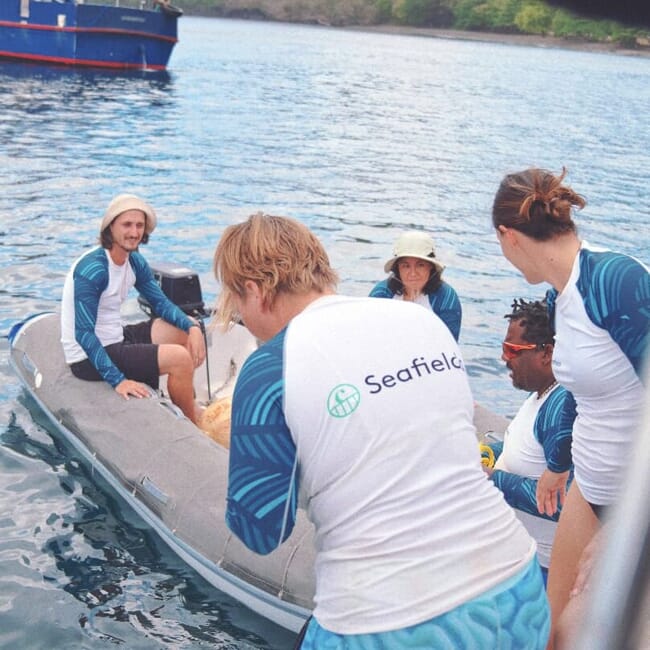
© Seafields
On the governance and regulation side, we are drafting a document, together with environmental and marine law experts, to track and ensure that we abide by the current and emerging legal and regulatory frameworks. Our current trials are taking place in the EEZ of St Vincent and the Grenadines and Mexico, where we have obtained permits for our activities. As we start upscaling and moving to international waters, we will need to ensure that our activities conform to the London Protocol, the Biodiversity Convention, other international laws and the emerging Ocean CDR Code of Conduct. Our team has expertise in laying and recovering telecommunication cables around the world, as well as extensive government and UN relationships, and we are confident of successfully navigating these issues.
Why are you focusing on carbon mitigation, given that the jury is still out on whether – and how – sinking seaweed can sequester carbon?
We are solely focusing on carbon removal, as stopping ongoing carbon emissions isn’t enough. We need to scrub existing pre-industrial CO2 as well, and quickly, to avoid us reaching key climate tipping points. The IPCC stated that carbon removal is a key element to limit warming to 1.5°C or 2°C. Current efforts are focused on cutting the 50 gigatonnes of CO2 (GtCO2) we emit each year, but little thought is being put into sequestering the ~1830 GtCO2 post-industrialisation emissions that remain.
We would need to plant 1.2 trillion trees to solve the problem terrestrially. The geopolitical challenge of this makes it practically unachievable, plus trees take time to grow and time is not on the planet’s side. We calculated that in the South Atlantic Gyre, there is enough space not occupied by major shipping routes to sequester 12 Gt of CO2 per year through Sargassum farms. In 2017 Duarte et al calculated that – if all the seaweed grown in aquafarms in 2014 was used for CO2 capture – a total of 2.48 million tonnes of CO2 (0.68 Tg C) per year would be captured. That is about 0.4 percent of the 0.634 Gt CO2 (0.173 Gt C) per year that wild seaweed captures (Krause-Jensen and Duarte, 2016). These numbers give a good overview of what would be possible with today's aquafarms and how much sequestration happens naturally.
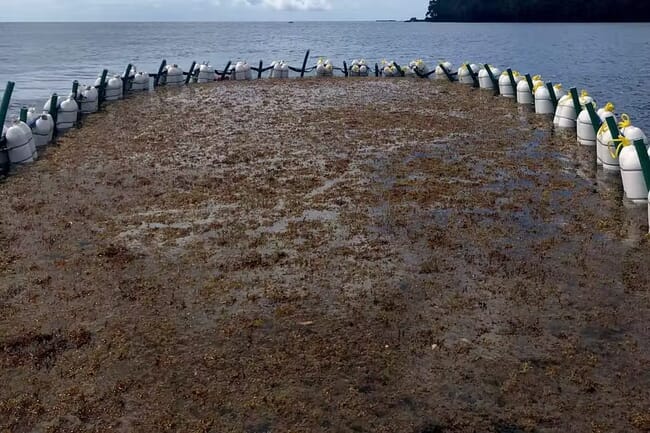
As carbon is removed from the ocean we will need to verify that this leads to carbon removal in the atmosphere. When there is a difference in CO2 concentration between the surface ocean and the atmosphere, this difference will be balanced out, although this is a process that takes weeks or months. To estimate how much of the CO2 taken out of the ocean is then pulled from the atmosphere back into the ocean, we need detailed measurement of CO2 concentration in the water and air in our farms. This, paired with modelling of how long the water parcels leaving our farm stay in contact with the atmosphere, will tell us how much of the carbon sequestered by our aquafarms can be considered sequestered from the atmosphere.
Our science team has extensive experience in monitoring climate change impacts in the carbon and nutrient cycles in the open ocean. They are aware of the challenges that ocean CDR MRV pose (e.g. accuracy of pCO2 measurements, considering the dilution of the signal, etc.) and are planning to using international monitoring networks (e.g. Argo floats, sail drones and satellites) as well as developing novel tools to improve the monitoring resolution for large scale operations. Using a combination of water and air sensors, we will monitor the air-ocean CO2 influx in our farms and control sites.
What other benefits will a giant seaweed farm bring?
By creating this aquaculture business we will be helping develop not just jobs for scientists, but also for fishermen and the wider economy too. This is basically a whole new agriculture system, but on the sea. Something that hasn’t happened for centuries, as we have been so focused on the land.
Seaweed cultivation contributes to several of the UN’s Sustainable Developmental Goals and it counteracts ocean acidification locally (Duarte et. al., 2017 and 2022)
Can you tell me a bit about the processing side of things and the products that you’re looking to develop for the portion of the crop that you don’t discard?
We will provide Sargassum year-round to industry, to produce products that work as substitutes for fossil fuels – such as biofertilisers, bioplastics and biofuels. This will contribute to carbon dioxide emission reductions globally.
Domesticating Sargassum in open ocean aquafarms will provide a stable source of raw material to the handful of small and medium-sized companies developing products from irregular but devastating influxes of Sargassum in the Caribbean.
Part of our harvest will also be transformed into bioethanol and other carbon-storing products in close collaboration with our partner, Carbonwave, the world’s largest processor of Sargassum.


